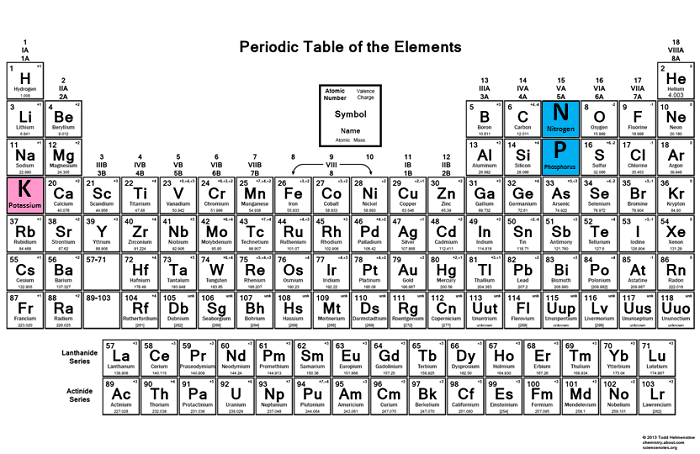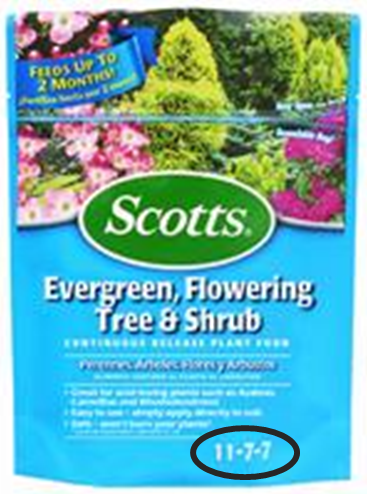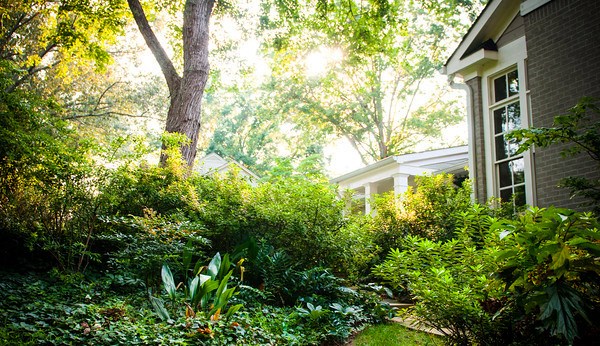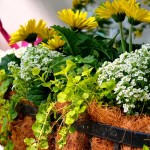Fertilizing Basics: The ABCs and NPKs of Fertilizer
A couple of weeks ago I started a series of posts on dirt…err, soil. The first was on the basics of what soil is…your plants’ home and its food. Last week I gave you some basics on why and how to amend your soil. Today’s post I’m going to explain the ABCs of fertilizing your plants and what those pesky #s and letters are on every bag of fertilizer.
![]()
Simply put…your plants need to be fed. If you have good compost-rich soil they’ll get much of what they need from there. However, most of us don’t have good soil…and like we need to have a good multi-vitamin to supplement what we get from the food we eat, your plants need a similar boost of nutrition…fertilizer.
Even if you start with great soil, over time your plants will absorb the essential nutrients they need to continue to grow big and strong…think tastier tomatoes, brighter flowers, and greener grass. Plants need 6 essential nutrients…3 of which they get from “above”…the air and water – Oxygen, Carbon, and Hydrogen. The other 3 they have to get from “below”…the soil they’re living in – Nitrogen, Phosphorus, and Potassium. That’s where those pesky #s and letters come in.
 On every bag of plant food…fertilizer, you’ll see 3 #s separated by dashes. If you take the time to look at the finer print you’ll see that they represent the 3 nutrients your plants are looking to get from the soil…again, Nitrogen (N), Phosphorus (P), and Potassium (K)…in that order.
On every bag of plant food…fertilizer, you’ll see 3 #s separated by dashes. If you take the time to look at the finer print you’ll see that they represent the 3 nutrients your plants are looking to get from the soil…again, Nitrogen (N), Phosphorus (P), and Potassium (K)…in that order.
 I could go all high school chemistry on you here by talking about what percentage of weight by element is in each bag of fertilizer and how the Phosphorus and Potassium are actually present in oxidized forms; however, all you need to know is that the bigger the number the more there is of that element…nutrient. So in the bag of fertilizer to the right…it is made up of 11% Nitrogen, 7% Phosphorus, and 7% Potassium. The remaining 75% are inert fillers. And don’t feel jipped by the words inert and filler…these fillers (e.g., clay and limestone) actually serve a purpose…like appropriately distributing the Ns, Ps, and Ks and preventing the chemical burn to your plants that would take place without them.
I could go all high school chemistry on you here by talking about what percentage of weight by element is in each bag of fertilizer and how the Phosphorus and Potassium are actually present in oxidized forms; however, all you need to know is that the bigger the number the more there is of that element…nutrient. So in the bag of fertilizer to the right…it is made up of 11% Nitrogen, 7% Phosphorus, and 7% Potassium. The remaining 75% are inert fillers. And don’t feel jipped by the words inert and filler…these fillers (e.g., clay and limestone) actually serve a purpose…like appropriately distributing the Ns, Ps, and Ks and preventing the chemical burn to your plants that would take place without them.
Now that you understand what these #s and letters stand for, let me give you a quick and dirty explanation as to why each of these nutrients are important to the health of your plants:
- Nitrogen (N) aids in leaf and vegetation development.
- Phosphorus (P) provides your plants’ roots what they need to develop. It is also what is primarily responsible for flower and fruit production.
- Potassium (K) helps your plants’ roots function properly (e.g., water regulation and moving nutrients to plant cells), as well as making your plants more disease resistant.
You might be saying… “That’s great and all, but I’m still confused…why are there so many choices in fertilizers and combinations of numbers? Well, just like we need different vitamins and nutrients if we’re sick or depending on how old we are, plants need a different proportion of nutrients depending on what’s going on with them. So…looking back at what value each nutrient provides:
- All-Purpose Fertilizers: Like a good ole’ multi-vitamin, fertilizers with equal parts N-P-K (e.g., 10-10-10) are used to promote your plants’ overall health.
- Promote lush green growth: If you’re looking to green things up…look for a fertilizer with a higher first number. Logically, you’ll see that grass fertilizers have a greater percentage of Nitrogen.
- Promote fruit and flower production: Since your plants only have so much energy to give, if you don’t supplement your plants with Phosphorus (essential for flower and fruit production) they will likely use what energy they do have to produce foliage. That said, to promote fruit and flower production, look for a fertilizer that has a higher middle number.
- Promote root growth: You’ll also find that starter fertilizers will have a higher middle number…greater percentage of Phosphorus…which is needed to promote root growth. Clearly this is an important function when a plant is first planted.
- Winterizing and disease prevention: Since during times of stress more phosphorus and potassium are needed to aid in plant cell development and to increase disease resistance, you should use a fertilizer with higher second and third numbers.
 Lastly, I’d like to provide you with several pointers when using fertilizers:
Lastly, I’d like to provide you with several pointers when using fertilizers:
- Labels: Make sure you read the label before using any fertilizer…for both reasons of safety and health for both you and your plants.
- New plants: With the exception of potentially using a root stimulater or starter fertilizer, you should resist the temptation to fertilize newly planted plants until after a full growing season. Otherwise, you risk burning their roots. But…if you read last week’s post and appropriately amended your soil, your plant should have all that it needs from the composted material to get it through its first year.
- More is not better: Generally speaking, when we get more vitamins than we need…well, we just “relieve” what we don’t use. That’s not the case with plants. If you give your plants too much fertilizer…thinking more is better, odds are you will burn the plant’s roots and make the soil a bit toxic. So less is more in this case. If you still want to show your plants so extra love, feel free to add more composted material in and around their soil.
- Root Zone = Drip Line: You should evenly distribute granular fertilizer at the plant’s root zone…which, generally speaking is also their drip line…where water would drop from its outer leaves. This will get the fertilizer where it most needs it…at its roots.
- Let it soak in: If you are using a dry fertilizer make sure to water afterwards. This will not only activate the fertilizer, but it will also minimize the risk of burning the surface of the roots.
- When to fertilize:
- Early spring is a great time to fertilize your perennials and vegetables…just before or as they start sending out new shoots.
- Your lawn, trees, and shrubs like a dose of fertilizer in early spring, as well as in early fall.
- Annuals (i.e., growing annually in different seasons), like to be fed during their respective growing seasons.
![]()
So there you have it…the ABCs and NPKs of fertilizers. I hope you found all this helpful. Please let me know if you have any questions…I’d be more than happy to help where I can. Next week I’ll conclude this series on dirt talking about soil samples and pH levels…again, trying not to get all high school chemistry on you.
Take care,

You may also enjoy these posts from RYG ...
If you're not already subscribed to RYG and want to get periodic updates, links to new posts & other ground redeeming info ... just enter your email address below. Easy as that!

![Fertilizing Basics [Video for Exmark]](https://redeemyourground.com/wp-content/uploads/2018/05/Exmark_RedeemYourGround_Fertilizer-Tips-4-150x150.png)




Love that education, Doug! I will indeed keep this post and refer to it. One question, what about potted plants? Should I use the same “rules”? Thanks!
Thanks Tricia! The basics of why to fertilize potted plants is the same, but there are a few different things to note on how and with what. When you plant your potted plants, make sure you use a good potting mix. There will be a good amount of nutrients for the plants in it, but it will be all used up in about 6 weeks. If your potting soil doesn’t have any fertilizer already in it, you can mix some slow-release fertilizer at the point of planting. Then every 2 weeks or so water with some water-soluable fertilizer to keep your plants nice and fed. If you notice your plants looking a bit strained, you can then give them a boost by spraying them with a water-soluable fertilizer. Container-plant specific fertilizers can be found at your big box stores or plant nurseries. Oh…and here are 2 links with more specific instructions that you might find helpful: http://www.almanac.com/blog/gardening-blog/abcs-fertilizing-containers, http://www.hgtv.com/gardening/fertilizing-container-plants/index.html.
I hope all this helps Tricia..and good luck with your container plants.
Take care, D.
I have had beautiful hydrangea before. I would like to know when would be the right time to get cuttings from our mountain house and plant at the new house. Could you give me some advice?
Thanks for this comment and question Helen. I plan on writing several posts that may touch on what you may be asking…hydrangeas in general, cutting hydrangeas, and propagating hydrangea. So stay tuned for those. But in the meantime, to quickly and directly answer your question…”when”…since most propagation efforts are done on softwood cuttings (i.e., new and green vs. old and hard/woody), now is a great time. And really anytime is good until there are no more softwood stems to cut, and as long as you have the conditions to allow them to grow. Here are a few links you might find helpful: http://www.hydrangeashydrangeas.com/propagation.html, http://www.nantuckethydrangea.com/propagation.html. Thanks again and take care, D.
I’ve always wondered what the heck those numbers meant. This definitely helps! Thanks, Doug!
So glad! And now you can’t say you have no use for the Periodic Table…well kinda! Take care Brandi! – D.
Thank you very much for the informative articles! I am planning to have a career in gardening, but am not taking any botany or gardening classes yet. These article on your blog are very helpful and encouraging. hopefully I will be able to enter into the UC Master Gardening Program. that all being said I am curious. Between regular and OMRI listed fertilizers which do you recommend? I’ve always been told Miracle Gro is like giving a Red Bull to a toddler; a huge burst of energy, then crash. Again thank you for taking the time to write good cohesive articles.
~Conner
Conner…thanks so much for reaching out. And I’m so glad you found the articles helpful. Sorry I’m just getting back to you…some comments got spammed inadvertently and I’m just finding them now. Good luck with your Master Gardening Program…stick w your passions my friend! As for fertilizers…my purist friends may boo me off of cyberspace, but I do what I can when I can. I try using organic material…compost…first, then organic fertilizers…then if I must regular fertilizers. I may have used Miracle Gro once on my outside plants…when we first moved into our home…i.e., before I really got into gardening, but haven’t since…for the some reasons you mentioned. I don’t know if this is very much help…but it’s my honest to goodness approach. Every year we try to “do better” from a “green” perspective than the year before. I think if I tried to be perfectly green from the get-go I don’t think I would have ever started…it would have been too overwhelming. Make sense? Thanks again for reaching out and I hope you have a nice week. Take care, D.